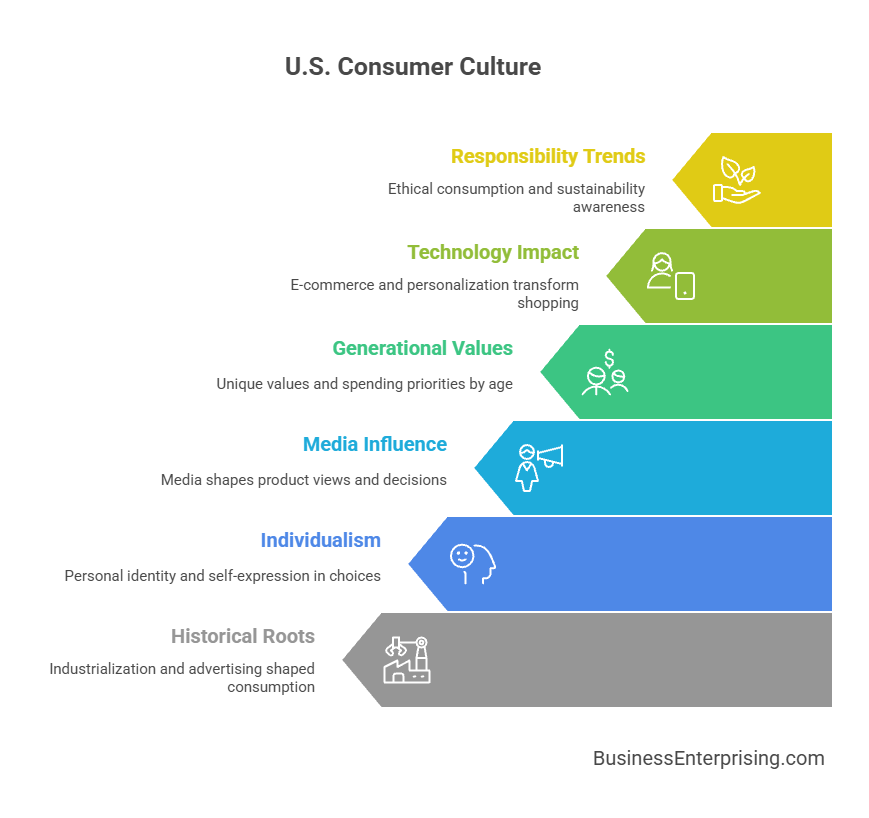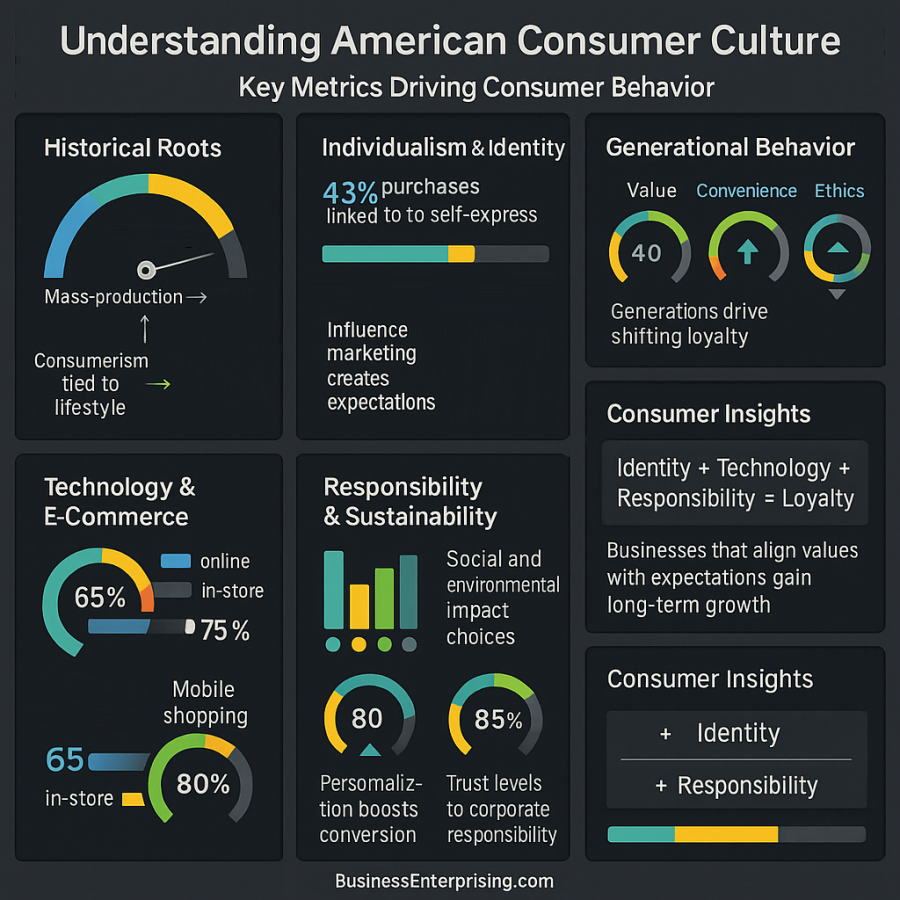
Additionally, your purchasing decisions often go beyond practical needs. You buy products that reflect your personality, lifestyle, and beliefs. Companies recognize this and design marketing that speaks directly to your sense of identity. As a result, brands compete for your loyalty by aligning with what matters most to you.
Moreover, the influence of media and technology has changed your habits. You now expect instant access, personalized experiences, and convenience in every transaction. Businesses must adjust strategies to match these expectations. Therefore, the rise of online shopping and digital platforms has transformed how you connect with products and services.
However, your values also play an important role. You want companies to demonstrate responsibility, whether through ethical practices, social impact, or environmental awareness. These expectations influence where you spend money. Therefore, consumer culture reflects both individual identity and collective responsibility.
By looking at these influences together, you gain a clearer understanding of how consumption shapes your daily life. Additionally, businesses that understand your values can build stronger connections and create strategies that serve you more effectively.
Historical Roots of Consumer Culture in America
The roots of consumer culture in America stretch back to the industrial era, when factories transformed how goods were produced. Mass production made items more affordable and accessible, changing the way you and others viewed daily consumption. With lower costs and wider availability, consumer goods became part of everyday life instead of being limited to the wealthy.
Additionally, advertising played a major role in shaping your perception of products. Early print ads and radio promotions encouraged demand by linking goods with aspirations and lifestyle choices. Therefore, marketing became more than simple promotion. It created emotional connections between products and consumers. As advertising grew, it influenced how you measured success and personal identity.
Moreover, the rise of department stores and catalogs further expanded consumer access. These outlets presented shopping as an experience, not merely a necessity. You could browse selections, compare items, and enjoy the act of purchasing. As a result, shopping developed into a social and cultural activity tied closely to the American way of life.
Therefore, industrialization, mass production, and advertising formed the foundation of modern consumption. They changed not only how products were made but also how you thought about them. Understanding American consumer culture requires looking back at these shifts and recognizing how they continue to influence present behaviors. By studying these historical roots, you gain perspective on why consumption still plays such a powerful role in shaping choices.
The Role of Individualism in Purchasing Decisions
Individualism plays a powerful role in shaping the way you make purchasing decisions. In America, consumer choices often reflect personal identity and self-expression. Brands are not only about products but also about how you define yourself through what you buy.
Additionally, freedom of choice influences how you interact with the marketplace. You value having multiple options that align with your needs and preferences. Therefore, companies compete to offer products that allow you to express individuality while feeling connected to larger cultural trends.
Moreover, your loyalty to certain brands often comes from the sense of identity they reinforce. Clothing, technology, or even food choices can become symbols of who you are. As a result, you may remain loyal to brands that consistently reflect your values and lifestyle.
However, this focus on self-expression also drives innovation. Companies adapt to changing consumer expectations by creating products that offer personalization and uniqueness. You are drawn to options that allow you to stand out while still feeling authentic. This cycle strengthens the role of individualism in the marketplace.
Therefore, understanding American consumer culture requires recognizing how identity and freedom shape behavior. When you choose a product, you often choose more than its function. You choose a symbol of your individuality, one that reinforces your values and sense of self.
Influence of Media and Advertising
Media and advertising have long shaped how you view products and make decisions. Television first introduced the idea that products could represent a lifestyle. Commercials tied brands to emotions, creating expectations that went beyond function. As a result, you began associating purchases with identity and aspiration.
Additionally, social media has changed how you discover and evaluate products. You are influenced by peers, influencers, and targeted ads that speak directly to your interests. Therefore, marketing has become more personal, making you feel connected to brands that understand your preferences and values.
Moreover, digital marketing strategies have set new standards for how companies interact with you. Businesses use data to predict your needs and deliver offers in real time. This creates a sense of immediacy and convenience. Therefore, your buying habits shift toward instant gratification and constant availability.
However, media also drives expectations for authenticity. You want transparency from companies and proof that their values align with yours. Advertising now includes storytelling that highlights social responsibility, diversity, or innovation. As a result, you respond not only to features but also to messages that reflect your beliefs.
Understanding American consumer culture means recognizing how media shapes choices. Television, social media, and digital marketing continue to influence what you buy and why you stay loyal to certain brands.
Generational Differences in Consumer Behavior
Generational differences play a major role in shaping how you and others spend money. Baby Boomers often value reliability and quality. Their purchasing habits lean toward established brands that provide consistency. Therefore, they remain loyal to products and services that have served them well over time.
Additionally, Gen X approaches consumption with practicality. They compare prices, look for value, and focus on balancing quality with cost. You can see this generation prioritizing efficiency and convenience in both online and offline shopping. Their choices reflect the need to manage busy lives while keeping spending under control.
Moreover, Millennials have shifted behavior toward experiences and social responsibility. They often prefer brands that align with personal values. Therefore, they support companies that show commitment to sustainability, diversity, or innovation. Their loyalty often depends on whether a brand’s message matches their beliefs and lifestyle goals.
Gen Z has introduced new priorities into the marketplace. They are highly digital, influenced by social media, and driven by personalization. You can see them expect authenticity and immediate access to products. Therefore, they are more likely to try new brands that provide relevance and connection through online engagement.
Understanding American consumer culture requires paying attention to these generational differences. Each group has unique values and spending priorities. When you compare these patterns, you see how consumer behavior continues to evolve and shape the broader marketplace.
Impact of Technology and E-Commerce
Technology has reshaped how you research and purchase products. Online shopping has created convenience by giving you access to countless options anytime. This shift changed the way businesses present products and the speed at which you expect service.
Additionally, mobile apps have transformed your shopping habits. With smartphones, you can compare prices, read reviews, and place orders within minutes. Therefore, companies must adapt to meet your need for instant access and seamless digital experiences. Convenience now plays a central role in decision-making.
Moreover, digital platforms personalize your shopping journey. Algorithms recommend items based on your past purchases and preferences. As a result, you encounter products that feel tailored specifically to your lifestyle. This customization encourages you to make faster choices while feeling understood by brands.
However, technology has also raised your expectations. You now look for speed, transparency, and clear communication from businesses. Companies that fail to deliver often lose your loyalty quickly. Therefore, digital convenience has intensified competition and forced brands to improve their systems continuously.
Understanding American consumer culture requires acknowledging how technology and e-commerce drive your choices. Online shopping and mobile apps have shifted buying from a physical experience to a digital-first one. When you shop today, you expect convenience, personalization, and instant results, making technology a defining influence on consumer behavior.
Trends Toward Social Responsibility and Sustainability
Consumer behavior in America has shifted toward greater awareness of social responsibility and sustainability. You often consider values before making purchasing decisions. Ethical consumption has become part of how you express priorities in the marketplace.
Additionally, environmental awareness influences your choices. You pay attention to packaging, production methods, and sourcing when evaluating brands. Therefore, companies are responding by adopting greener practices and promoting eco-friendly initiatives. These efforts appeal to your desire for products that reflect responsibility toward the environment.
Moreover, corporate responsibility now affects brand loyalty. You want businesses to contribute positively to society, whether through fair labor, charitable efforts, or transparent practices. As a result, you may avoid brands that ignore these expectations, rewarding those that act responsibly.
However, your demand for accountability continues to grow. You expect businesses to provide proof of their efforts, not simply make promises. Therefore, certifications, reporting, and transparency have become important signals of trust. This trend pushes companies to maintain consistent action.
Understanding American consumer culture requires examining how responsibility influences buying. Ethical consumption and sustainability are no longer niche priorities. They represent mainstream values that shape what you buy and which brands you support. Your choices now send strong signals about the importance of responsibility in business.
Conclusion
Consumer behavior in America reflects history, culture, and evolving expectations. From mass production to digital commerce, each stage has shaped how you purchase. The choices you make today often reflect identity, values, and convenience. Therefore, businesses that adapt to these influences gain your loyalty and long-term support.
Additionally, generational differences show how consumer behavior is far from uniform. Each group prioritizes different values, from reliability to sustainability. This variety makes understanding American consumer culture an important step for any business hoping to serve you effectively. Moreover, technology continues to drive change, offering you new levels of convenience and personalization.
However, responsibility and trust have become stronger forces in the marketplace. You expect companies to provide transparency, accountability, and products that align with broader social goals. Therefore, businesses must integrate responsibility into strategies if they want your continued attention and commitment.
Understanding American consumer culture provides perspective on why consumption looks the way it does today. Your decisions are shaped by identity, technology, generational values, and responsibility. Additionally, your purchasing choices send clear signals to companies about what matters most to you. By recognizing these patterns, businesses can meet your expectations while building stronger connections.



